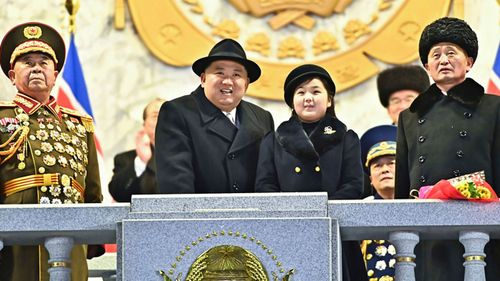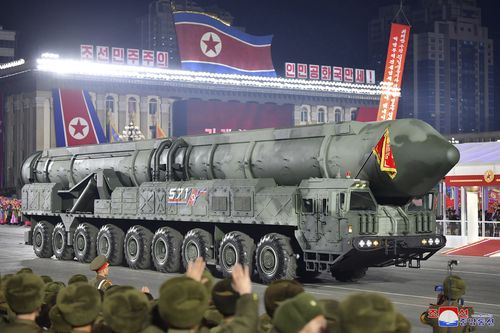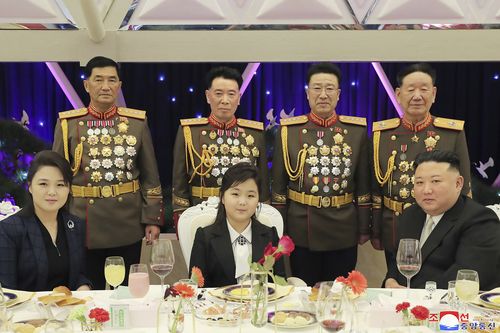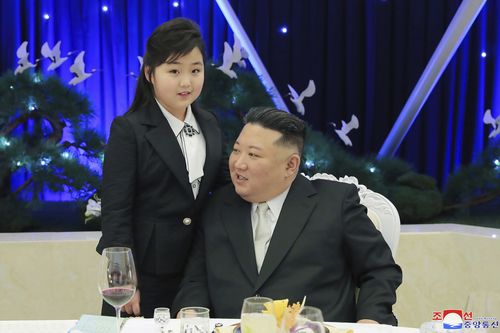The appearance of North Korean leader Kim Jong-un’s daughter alongside her father during a military parade this week has fuelled speculation the girl is being groomed as his eventual successor.
The girl – believed to be Kim’s second child, Ju-ae, who is aged about nine – on Wednesday watched with Kim as massive intercontinental ballistic missiles were paraded through Pyongyang’s Kim Il-sung square in a military parade.
Earlier on Tuesday, she joined the North Korean leader and his wife, Ri Sol-ju, during a visit to a military barracks and subsequent banquet to mark the 75th anniversary of the founding of the Korean People’s Army, state media reported.
READ MORE: North Korean troops encouraged by Kim Jong-un and his daughter

She has now made five appearances in less than three months, fuelling speculation she could become a future leader of the secretive nation.
A Korean Central News Agency (KCNA) report described seeing Kim and “his respected” daughter at the Tuesday night banquet as a dream come true for the military officials present.
GALLERY: Kim Jong-un shows off ‘unprecedented’ missile strength at military parade
Pictures published by the state-run Rodong Sinmun newspaper showed the girl walking next to Kim and her mother as they entered the venue for the banquet while military officers applauded.
At the banquet, the girl was seated in the centre of the lead table between Kim and her mother.
READ MORE: Here’s what we know about Kim Jong-un’s children

In November, she attended a flight test of an intercontinental ballistic missile and has accompanied her father to a meeting with military scientists and an inspection of ballistic missiles.
Analysts say Kim’s decision to bring her daughter to public events tied to his military is to remind the world he has no intentions to voluntarily surrender his nuclear weapons, which he apparently sees as the strongest guarantee of his survival and the extension of his family’s dynastic rule.
In a country where the Kim family and the military are all powerful, the presence of the girl at such an important event sends clear signals, said Leif-Eric Easley, a professor at Ewha University in Seoul, South Korea.
“By ostentatiously including his wife and daughter, Kim wants observers at home and abroad to see his family dynasty and the North Korean military as irrevocably linked,” he said.
READ MORE: US reveals what was inside Chinese balloon

Other observers said it’s clear Kim has made a choice of his successor, confirming speculation that began with the girl’s appearance in November at the missile launch.
South Korean MP and secretary of the National Intelligence Service Yoo Sang-bum said after that launch that the girl was thought to be Ju Ae.
Images showed the two walking hand in hand while inspecting the massive missile, while state media called her Kim’s “beloved” daughter.
North Korean state media published a story later that month with pictures of Kim and his daughter, describing her as his “most beloved” child, said Cheong Seong-chang, a senior analyst at the Sejong Institute in South Korea.
“Considering these, there is no longer any doubt that Kim Ju-ae has been appointed as the successor to Kim Jong-un, and it is necessary to pay attention to how this will affect North Korea’s domestic and foreign policies in the mid- to long-term, and how North Koreans will accept the succession of the fourth generation,” Cheong said.
READ MORE: Police divers end search for missing UK woman in river

The Kim family’s rule in North Korea stretches back to 1948, when Kim Il-sung came to power in the aftermath of World War II.
When he died in 1994, his son Kim Jong-il took control of the country.
Kim Jong-un came to power in December 2011 after the death of Kim Jong-il, his father.
There’s no indication Kim Jong-un would pass on the leadership anytime soon.
North Korea is facing deepening economic isolation and food shortages, showing the costs of Kim’s nuclear ambitions are piling up.
The nation is coming off a record-breaking year in weapons testing, and the dozens of missiles it fired in 2022 included potentially nuclear-capable systems designed to strike targets in South Korea and the US mainland.
